NCC's new Happy Valley Forest Hike Series
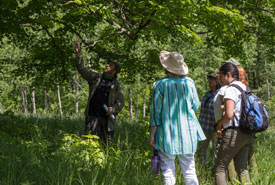
Participants listen in as Todd Farrell talks about the plants in Happy Valley Forest (Photo by Evelyn Senyi)
City, meet nature
“How far do you think we are from Dundas Square?”
It’s an odd question that Todd Farrell, coordinator of conservation biology in central Ontario for the Nature Conservancy of Canada (NCC), poses to a group of nature nerds on a sunny, hot June morning. We are surrounded by the soft sigh of a light breeze through the tall grasses of the meadow, the trilling songs of forest birds and the chirp of grasshoppers playing at our feet.
Yet the answer to this question is surprising. We are in fact only 49 kilometres from Dundas Square, the heart of downtown Toronto, Canada’s largest city.
When you think of a nature reserve or protected area, it’s usually hours away from civilization, deep in the heart of the Canadian wilderness. However, NCC’s Happy Valley Forest is literally minutes away from the bustling congestion of the GTA in King Township.
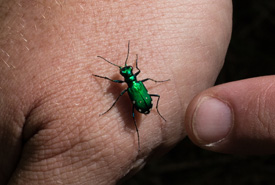
Six-spotted tiger beetle (Photo by Nicole Evelyn Senyi)
Once known only to conservationists, Happy Valley is now becoming a popular destination thanks to NCC's new Happy Valley Forest Hike Series. Led by NCC staff and conservation experts, the hikes feature topics such as bats, birds, botany, trees and butterflies, encouraging nature-starved city dwellers to get outside and learn more about this rare natural gem.
“Participants will enjoy a walk in a wild natural area and come away with a better understanding of some of its habitats and inhabitants,” says Mark Stabb, central Ontario program director for NCC.
Botany 101
The topic for today’s hike is botany. I’ll admit it: I find plants boring. I’m more of a mammal girl myself. Nothing gets me more excited than searching paths for the tracks and scat of large predators. But I decide to give the greenery thing a chance. And I’m pleasantly surprised.
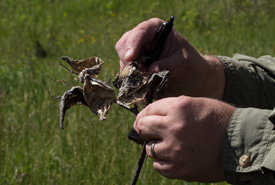
An old milkweed pod. Todd identifies plant species left behind by last year's growth (Photo by Evelyn Senyi)
Farrell, our leader, makes the topic interesting, pointing out different plants and talking about their reproductive cycles as we walk along the cool, shady paths of the forest. He comments on the local ecology, telling us which plants are native, which are introduced and which are invasive (there are far too many in this last category I’m afraid). He also shares interesting facts like how the milkweed seed floats like a parachute and parts of the fruit were once used in life preservers in World War II.
Aside from the botany lesson, hike participants learn something about the forest itself.
The 300+ hectares of conservation lands in the Happy Valley Forest are broken up into several parcels, the most accessible of which is the Goldie Feldman Nature Reserve, the launch point for the majority of the guided hikes. Located off of 17th Sideroad, just west of Weston Road and north of Highway 11, the reserve has a small parking area and a seasonal outhouse.
We take the four-kilometre, easy, loop trail with a lookout that is part of the greater Oak Ridges Trail network. Along the way, interpretive signs highlight the many natural features and history of the area. The trail is well marked, with boardwalks for wetter sections.
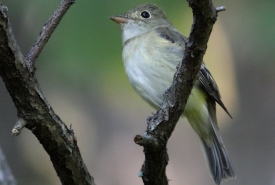
Acadian flycatcher (Photo by Bill Hubick)
NCC’s Happy Valley Forest Natural Area is one of the largest remaining intact deciduous forests on Canada's Oak Ridges Moraine. The mature sugar maple and beech forests support more than 110 bird species, along with rare and unique plants. The area also holds special historical significance as a portage and travel route.
“The reason we work here is because of the older-growth forests and some unique species such as the Jefferson salamander and Acadian flycatcher,” says Farrell.
When to visit and what to bring
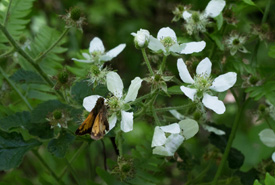
The Happy Valley Forest is carpeted with wildflowers and attracts many species of butterflies (Photo by Evelyn Senyi)
Each season at Happy Valley has its charms, however as a photographer I think that spring, with the forest floor carpeted in trilliums and other wildflowers, and fall, with the vibrant changing colours of the deciduous trees, are the best times to experience the area.
“There is always something to see in the amazing and beautiful Happy Valley Forest. Spring is a great time to visit as the birds are returning and the plants are blooming! This time of year, especially in the morning, the forest rings with bird song. The fall is great for fungi and a terrific display of colour. In winter the woods are quiet and serene, with few people,” says Stabb.
The presence of ticks and poison ivy make it a good idea to wear long pants and bring some bug spray. Personally, I found few bugs, but then I am a seasoned northern Ontario camper who has a high tolerance for our national bird, the mosquito. I do recommend a hat, sunscreen and LOTS of water for the hikes. Leashed dogs are also welcome on the trail and many of the upcoming hikes are family friendly.
NCC’s Happy Valley Forest Hike Series runs from now into the fall, with new hikes being posted each month. Go to the event page to register for an upcoming hike.


